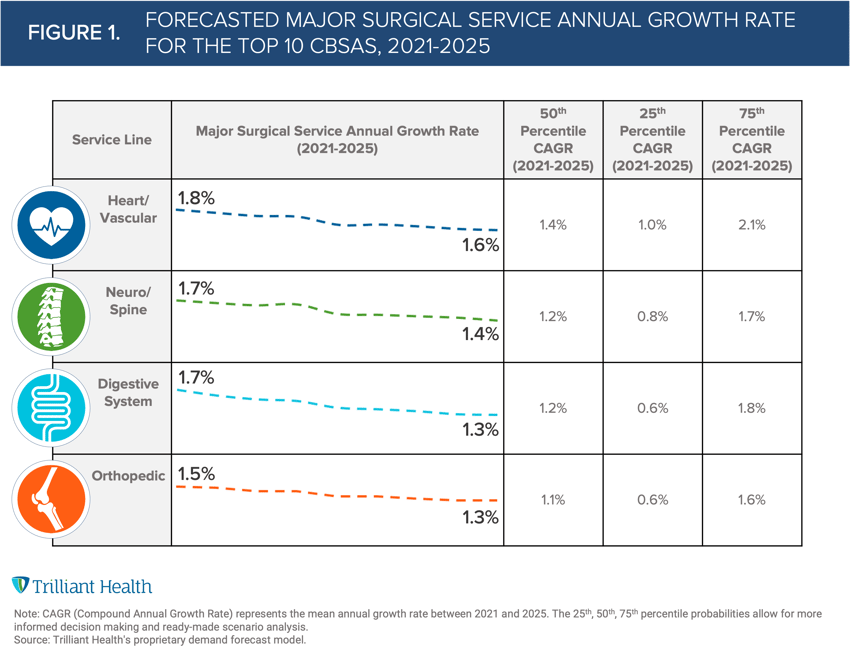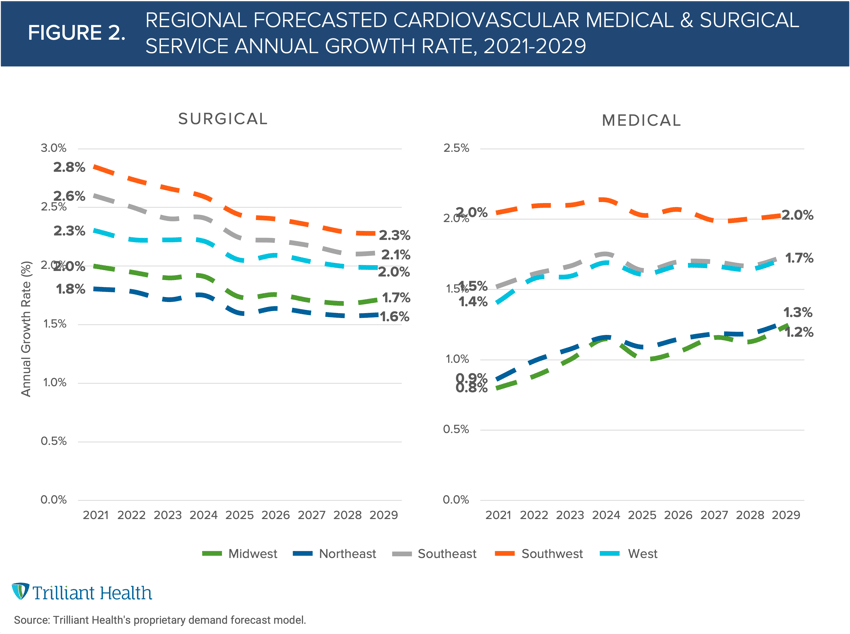The Compass
Sanjula Jain, Ph.D. | December 5, 2021Demand for Surgical and Medical Cardiovascular Services Forecasted to Have Different Growth Trajectories
Amid growing evidence of excess mortality and higher acuity being attributed to delays in care during the COVID-19 pandemic, targeted service line-level strategies have never been more important. The level of complexity in our industry is sufficiently challenging without the unpredictability induced by the pandemic, making it impossible to accurately anticipate future needs without probability-based models at a market level. Probability-based predictions of healthcare demand enable more accurate planning of physician staffing, therapeutic distribution, and medical device supply, to name a few.
Across the ten largest CBSAs, growth in surgical demand is forecasted to decline across major service lines (Figure 1), with annual growth rates declining by as much as 30%. Although heart and vascular disease is the leading cause of death in the U.S. and obesity continues to increase, the burden of disease does not always directly correlate future demand for services.
To reinforce the necessity of scenario planning, we calculated the compound annual growth rate across service lines according to the forecasted 25th and 75th percentile probabilities.

Our analysis reveals that the growth rate in cardiovascular surgical demand (e.g., coronary bypass surgery, mitral valve repair) is projected to decline, although more slowly than other major service lines, but growth in cardiovascular medical demand (e.g., electrocardiography, stress tests) is projected to increase or remain flat (Figure 2). The Southwest is projected to have the highest average annual change for both cardiovascular medical (2.0%) and surgical demand growth (2.3%) by 2029. In contrast, the Northeast is projected to have the lowest average annual change for surgical demand growth (1.6%), while the Midwest will see the lowest average annual change for medical demand growth (1.2%) by 2029.

Our analysis clearly demonstrates that projected demand across service lines (e.g., OB/GYN, behavioral health) is not uniform locally, nor nationally. No two health systems, markets, or facilities will experience the same demand curve, despite national growth in disease burden, especially for cardiovascular disease.
The impact of COVID-19 adds significant complexity in developing future care strategies. In examining the indirect impacts of COVID-19, enhanced cardiovascular disease progression due to foregone care remains a top concern. Research has shown that heart disease deaths increased following the COVID-19 pandemic, compared to prior years. Understanding the pandemic’s impact (i.e., growth rate, regional variation) on demand for cardiovascular services in the years ahead is necessary to prevent excess mortality and curb preventable disease progression.
Thanks to Kelly Boyce and Katie Patton for their research support.
- Specialty Care
- Disease Burden
You are currently viewing a free preview of our premium studies. To receive new studies weekly, upgrade to Compass+ Professional.
Sign UpSee more with Compass+
You are currently viewing the free version of this study. To access the full study, subscribe to Compass+ Professional for $199 per year.
Sign Up for Compass+